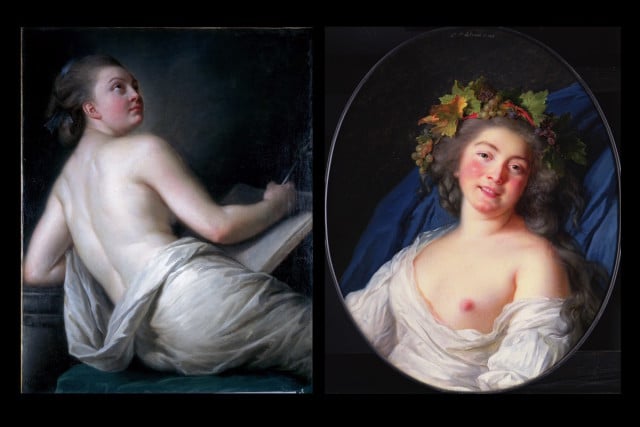
THE DAILY PIC (#1489): In so-called Old Master art, every female nude that was made by a woman also worked as a self-portrait – at least in the eyes of the male buyers and viewers of pictures. I came to that sudden awareness as I looked at (I’d hate to say ogled) these two naked women painted by the 18th-century artist Elisabeth Louise Vigée Le Brun (1755–1842). They are now in her utterly fascinating survey opening Monday at the Metropolitan Museum of Art in New York – shamefully, the first such show she’s ever had.
There’s no way that the men who saw these two nudes did not, in their little Homo erectus brains, imagine that they might just be getting an undressed glimpse of the artist who painted them.
Women artists were so rare during Vigée Le Brun’s time that their works automatically came with a sexy frisson of transgression. On the rare occasions that these artists transgressed even further by painting the female nude, normally the exclusive territory of their male colleagues, the combination of female subject and female painter would have shot the testosterone count through the roof. And since women were forbidden from drawing or painting the naked models that male artists had access to, the possibility that they had instead stripped themselves in a mirror would have automatically come to mind.
Even if a (male) viewer knew perfectly well that the skinny Vigée Le Brun looked nothing like the voluptuous figure that she’d painted, the tantalizing fantasy of the nude female artist would have been there for the thinking – if only to counter the threat that a woman with a paintbrush posed to male privilege, not to mention to other male things that begin with a ‘p’. (You don’t have to be Freud to see that.)
I wonder if the demure, almost virginal image that Vigée Le Brun projected in her actual self-portraits was meant to work as a cold shower for her male patrons, so she could get out from under their mental pawing. She needed to put as much distance as she could between herself and the female nudes that she refused not to paint.
One of the surprises of the Met show is how much of Vigée Le Brun’s patronage actually came from women, and how the mass of her female portraits – her signature product – captures a world of strong and independent agents. I admit that I came to the show imagining that I’d see a pile of excellent portraits by a painter who happened to be female and who would inevitably channel the all-powerful male values of her time. Instead, I came away with a vision of what it once meant to be a woman, and to break free of the limits that men imagined they’d set. (Top left, ‘Allegory of Poetry,’ Collection of Henry and Catherine Robet; top right, ‘Bacchante,’ Sterling and Francis Clark Art Institute, Williamstown, Mass.; above, ‘Self-portrait’, Galleria degli Uffizi, Corridoio Vasariano, Florence)
For a full survey of past Daily Pics visit blakegopnik.com/archive.